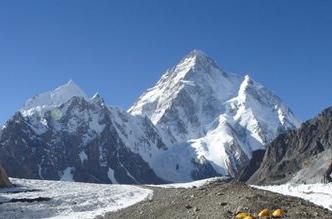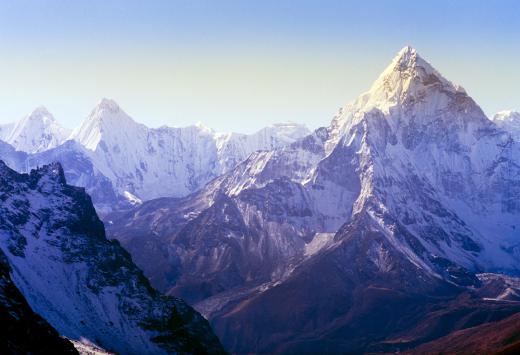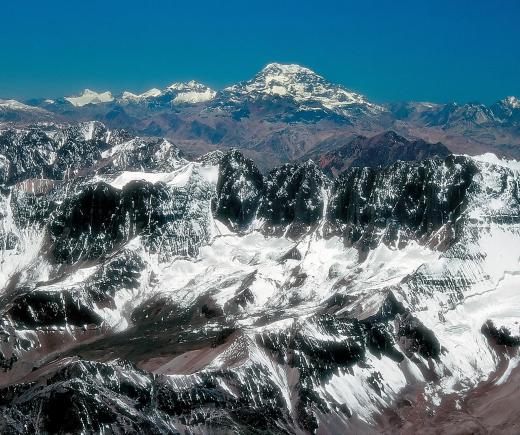How Were the Himalayas Created?
 Michael Anissimov
Michael Anissimov
The Himalayas, in Pakistan, India, Nepal, and China, is the world's tallest mountain range. It was created when the tectonic plate that holds the Indian subcontinent ran into the Eurasian plate, which holds Europe and most of Asia. As the two plates pushed up against each other, the land was pushed up, forming the mountains.
Mt. Everest, the world's tallest mountain at 8,848 meters (29,029 ft) above sea level, is found in this range, along with nine other peaks over 8,000 meters (26,246 ft) in height, called the Eight Thousanders. The range outclasses every other mountain range in the world, and the tallest mountain outside Asia — Aconcagua, in the Andes — is only 6,962 meters (22,841 ft) tall. The Himalayan range also has the world's largest concentration of glaciers outside the polar regions.

Though the mountains in the Himalayas are the world's tallest, they are also among the youngest mountain ranges on the planet, with the substantial growth occurring in just the last million years. They began growing about 50 million years ago when the Indian subcontinent, which used to be an island continent beneath Eurasia, slammed into the Eurasian continent due to continental drift. Prior to this, the Indian plate was one of the fastest-moving tectonic plates in the world, traveling northward at a rate of 6.3 inches/year (16 cm/year).

When the Indian plate hit the Eurasian plate, parts of the former began to subduct (go beneath) the other, and its rate of movement slowed by about half. The soft sediments that covered the northern edge of the island continent began to crumple, being uplifted, while the Indian Plate also pressed the Eurasian plate upwards. This is the birth of the Himalayas. They emerged in the former location of the Tethys Ocean, which had existed for 200 million years prior. Even today, fossils of coast-dwelling creatures can be found in the mountains, as the high peaks were once part of the Indian coastline.

Some of the greatest earthquakes in history have occurred due to tectonic forces released by the interaction between the Indian Plate and the Eurasian Plate. More recently, in the last few million years, the mountains have stopped growing as quickly. Scientists think that this may be because the Eurasian Plate is starting to stretch out rather than just being uplifted. Still, this mountain range has the highest rate of uplift in the world, rising by about 5 mm per year. This rate of uplift, which calculates to about 3.1 miles (5 km) per million years, is not likely to be kept up for long.
AS FEATURED ON:
AS FEATURED ON:














Discussion Comments
By carefully observing Google Earth, one can understand the formation of Himalayas is just due to folding of Earth's top surface. It appears like a huge celestial body tangentially making contact with Earth and exploding at the place where now the Taklimakan Desert is, has caused the huge movement of the Earth's surface and hence the Himalayas are formed.
Further, it appears that the exploded parts of the celestial body have formed all the deserts in China, Arabia and Africa including Taklimakan. Keen observation of Google Earth brings more clarity.
Not all of the mountain ranges part of the Himalayas were formed this way. There were some previously existing mountain ranges that became connected to the Himalayas after the clash of the continents. So we refer to all of these mountains as the Himalayas.
For example, the Hindu Kush was not formed at that time, but it's included in the Himalayas. There are a few others like this but I don't remember their names right now. There are more than one hundred mountains altogether that are part of the Himalayas so it's not possible to know them all.
@turkay1-- Yes, the Himalayas are still rising due to this clash.
I'm doing my thesis on the movement of tectonic plates and I've read a lot about the formation of the Himalayas. The Himalayas actually would not have been formed if the coast of the Indian continent had been composed of heavier material. When the continent slammed into Eurasia, the heavy consistency of the ridges would have broke apart and sunk to the ocean floor. But they didn't do that, it was composed of sediment, so it built up into mountain ranges instead.
This is why Himalayas are very unique.
The article mentioned that the Himalayas are uplifting, is this uplifting still the result of the Indian continent slamming into Eurasia?
Aside from the creation of the Himalayas, were there an other effects of this clash?
Post your comments